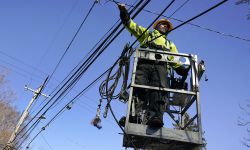Controversial youth detention tool goes live in Michigan. Is a fix coming?

- New requirements for screening arrested youth when determining whether to detain them take effect Oct. 1
- Answers to queries about views on the juvenile justice system, family members’ arrest history could factor into whether a youth is detained
- Lawmaker who said the tool jeopardizes success of juvenile justice reforms is working with court officials on a fix
LANSING — A change to Michigan’s juvenile justice system that critics fear could increase detention rates for youths of color took effect Tuesday, but advocates and a key state lawmaker are still seeking a fix.
Starting this week, local officials are required to implement a new six-question screening tool when deliberating whether arrested youths should be detained as their case proceeds. Detention screening was included in a legislative overhaul of Michigan’s juvenile justice system that was ordered to be ready by Oct. 1.
The goal was to remove some of the subjectivity from the process and steer nonviolent youths to diversion programs or informal probation instead of locking them up while their case is adjudicated. Last year, nearly 10,000 youths were arrested in Michigan.
Related:
- Critics fear reforms may boost incarcerations of minority youths in Michigan
- In Michigan, juvenile justice carries high cost: crippling debt for parents
- Michigan lawmakers vote to end most juvenile court fees, citing harms
Court officials based Michigan’s screening tool on one used in Ohio and contend it is an accurate predictor of whether minors across all race groups are likely to commit future crimes.
But critics — including Rep. Amos O’Neal, a Saginaw Democrat who sponsored the screening legislation — contend several questions included in the new screening model could exacerbate existing racial disparities in the juvenile justice system and result in more youth detainments.

Questions of most concern to observers include: whether the youths have a “negative attitude” toward the juvenile justice system, whether they have difficulty controlling anger and if any relatives have been arrested.
The screening tool, as designed by the state, is “not fair, it’s inhumane, it’s discriminatory and it’s not right,” O’Neal told Bridge Michigan last month.
State Court Administrator Tom Boyd recently told Bridge that the state needed to adhere to the Oct. 1 deadline “because children and families cannot wait any longer for reform.”
A spokesperson with O’Neal’s office said this week that the lawmaker is now working with state court officials and Gov. Gretchen Whitmer’s administration on a possible compromise, declining to give any specific details. For now, though, O’Neal was told the screening tool “does have to be implemented” on schedule.
Whitmer’s office did not directly respond to a question about deliberations around the new detention screening tool, but spokesperson Stacey LaRouche told Bridge the administration “remains committed to protecting the safety and well-being of youth in the juvenile justice system.”
“We will continue to work with anyone to build a fairer and more equitable criminal justice system,” LaRouche said.
Local officials’ use of the six-question screening following a minor’s arrest is required to be eligible for increased state reimbursements for juvenile justice costs, though the State Court Administrative Office has said screening results can be considered alongside other factors, including court rules, professional judgment and the reason behind the request for detainment.
Rhonda Ihm, president of the Michigan Association for Family Court Administration and a court administrator in Genesee County, told Bridge that court officials around the state are prepared to follow the new rules and are not opposed to pre-detention screenings as a concept.
But she fears that the practical result will be local courts frequently overriding the tool and defeating the purpose of having a statewide standard in place.
“Courts are going to do their best and use additional information to help make the decisions,” Ihm said. “And in the end, if they have a child that they don't think needs to be detained…they'll override the tool.”
Several states have approved risk screening tools at various stages of juvenile justice involvement, and in Michigan, a handful of counties had already developed their own systems to screen youth ahead of possible detention.
State court officials chose the Ohio Youth Assessment System, a screening tool built by the University of Cincinnati Corrections Institute designed to assess a juvenile’s likelihood of future delinquency, as the basis for a statewide screening standard in Michigan.
The tool recommends high-risk juveniles should receive “more intensive services and supervision,” while lower-risk youth could be offered an informal probation, community services or other diversion programs offered locally.
Screening topics would include:
- Any prior offenses
- Any possible criminal charges related to the current arrest
- The youth’s age at the time of their first contact with the juvenile justice system
- Whether any of the youth’s family members have been arrested
- If the youth has “difficulty controlling anger”
- Whether the youth has a “negative attitude” toward the juvenile justice system
Depending on a youth’s responses during an in-person interview, they will be categorized as low, moderate or high risk of future delinquent behavior.
See what new members are saying about why they donated to Bridge Michigan:
- “In order for this information to be accurate and unbiased it must be underwritten by its readers, not by special interests.” - Larry S.
- “Not many other media sources report on the topics Bridge does.” - Susan B.
- “Your journalism is outstanding and rare these days.” - Mark S.
If you want to ensure the future of nonpartisan, nonprofit Michigan journalism, please become a member today. You, too, will be asked why you donated and maybe we'll feature your quote next time!





